MAJOR CARLTON WEAVER RECALLS EARLY GRANTSVILLE DAYS - Earns His Wings
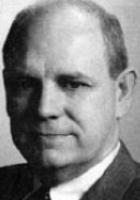 Carlton "Buck" Weaver (early photo, left) is a man for all seasons, after growing up in Calhoun County.
Carlton "Buck" Weaver (early photo, left) is a man for all seasons, after growing up in Calhoun County.
Weaver's life experience stems from fulfilling the vision of his parents to get an education, to being a Marine fighter pilot and serving in World War II and the Korean War, to obtaining a degree in engineering, to having a long career as an executive with Ashland Oil.
In between, he has been a scrupulous genealogist and collector of rare maps, his collection now housed at Marshall University.
The 85-year-old Weaver, now a resident of White Sulphur Springs, has hobbies of map collecting and genealogy, which have led to the establishment of the Carlton Weaver Trans-Allegheny Map Room at Marshall University to the publishing of a long-time effort, tracing his family roots: "Origin of a Trans-Allegheny Pioneer Family - Identifying the Ancestry of Henry Weaver 1747-1830."
Weaver is not unlike hundreds of Calhoun natives, graduating from Calhoun County High School in 1938, and leaving the hills to make a significant contribution to the greater world.
Major Weaver, born in 1921 in Grantsville, expresses deep gratitude to his parents Arley E. (1887-1967) and Grace Davis Weaver (1892-1954), saying "My parents managed to send me to the Citadel," after which he attended Marshall and West Virginia University, obtaining a degree in engineering.
"My parents somehow managed to survive the Great Depression in Grantsville WV, bound and determined to see that I got an education," said Weaver, including "My mother giving piano lessons for fifty-cents."
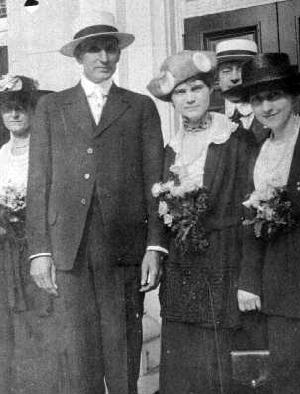
Carlton Weaver's parents, Grantsville businessman,
educator and Calhoun superintendent of schools,
Arley Weaver (1887-1967) and wife Grace Davis Weaver
(1892-1954), music, piano and violin teacher
taken at their wedding in Washington DC in 1920.
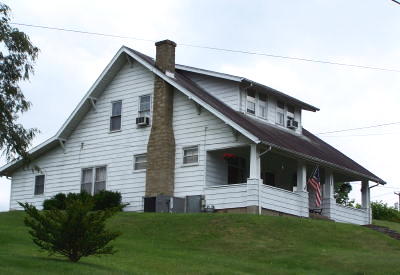
Carlton Weaver's family grew up in this house, now owned
by Orvin and Virginia Buck in south Grantsville. His sister,
Mary Kathryn Busch was a graduate of Western Kentucky
University and his brother, attorney William C. Weaver
was a graduate of George Washington University, both deceased
During his childhood days in Grantsville, "I learned a few lessons about business, delivering the Parkersburg News all over town, getting up at six o'clock," and working at the Grantsville Lumber and Planing Company, owned by his dad and his dad's brother, Frank Weaver.
"I was impressed that Sen. A. G. Matthews had a chauffeur. Sometimes I had trouble collecting from a few notable customers who had yet to sober up from the night before."
"I was mightily impressed by the Leason Proudfoot family who lived very humbly in the tiniest house off Mill Street, with nearly all of them going to college and becoming outstanding citizens."
Weaver said he was fascinated with a local eatery and tavern, the Coney Island Lunch, operated by "the Greeks" who lived on north side. They had booths that had curtains that could be pulled, for privacy. "They were the only Catholics in the county," he said.
The tavern was located in the general area of the current location of the Calhoun Bank on Main Street. In addition to their hot dogs, they were known for various bean dishes, including chili. Once, when their pressure cooker was cooking beans, it blew up, the windows of the establishment were knocked out, scattering beans across Main Street.
One of the Greek's, John Gusta Dandos, served in WWII, receiving the highest non-commissioned rank of Chief Petty Officer in the US Navy.
The Weaver mill was built on poles near the mouth of Simon's Run, with the saws and planers powered by natural gas engines. "All the shavings dropped into the creek and floated down the Little Kanawha," he said.
Arley and Frank Weaver delivered the lumber and built several of the houses that are still standing in Grantsville.
Arley Weaver also invested in the entertainment world, a "stockholder" in Grantsville's first and only silent movie house, located in what was known as the American Legion building (just blow the Rainbow Hotel) on Court Street.
"They only had one projector, so you had to wait for the projectionist to change reels to continue watching Tom Mix, Ken Maynard or Charlie Chan."
Weaver recalled that Baptist minister Rev. N. H. Bartlett came into the movie house looking for his son Starling Bartlett, taking him by the ear and removing him from the building. "Movies, dancing and wild music were unacceptable to the faithful," he said.
"Dad somehow came into $100 in 1934, and took our family to the Chicago World's Fair," said Weaver, who was only thirteen at the time. "You could get over five gallon of gas for a dollar," he said.
Getting near Chicago, the family stopped to pick-up a hitchhiker on his way to the fair, a member of the American Legion, who clung to the car, riding on the "running board," a fixture now missing from American automobiles.
"Not only did we go to the fair, we went to the Museum of Modern History and the Chicago Art Institute," he said.
His ancestors were among the first to move into the land that later became West Virginia, emigrating from Germany through Pennsylvania to what became Monongalia County, including an area known as White Day Creek.
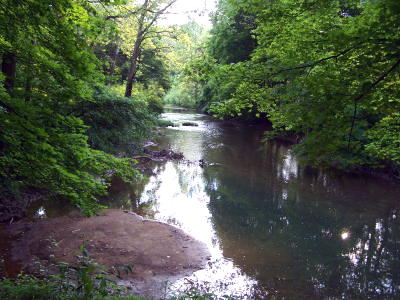
White Day Creek on the Marion County line still holds
some of Monongalia County's oldest structures, an area
broadly researched by Carlton Weaver, the location of a farm
and grist mill owned by Henry Weaver, 1747-1830
He became fascinated with land on which his ancestors lived and traveled. He began devoting his spare time to collecting maps of the Trans Allegheny region. His collecting took him to map dealers throughout the United States, as well as London.
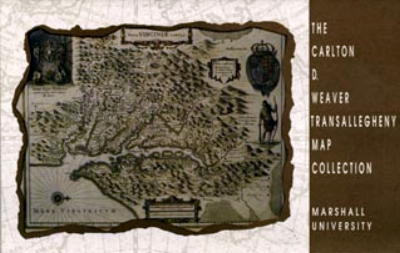
In 1992 Weaver donated his extensive map collection
to the library at Marshall University, which is housed
in the Special Collections section of Morrow Library.
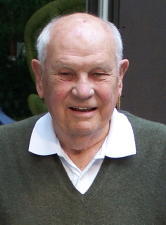 Now 85-years-old, Carlton D. Weaver reflects on his varied life experiences
Now 85-years-old, Carlton D. Weaver reflects on his varied life experiences
TAKING TO THE SKY - Fulfilling Dreams To Fly
By Carlton D. Weaver
My first year (1938) in college was at The Citadel. Near the end of my freshman year, Dad advised that I should not re-enroll at The Citadel because my sister was starting college and we needed to reduce costs, so I enrolled at Marshall University, a WV in-state school.
I could not earn a professional engineering degree at Marshall, so in the fall of 1940, I enrolled at West Virginia University as a junior in the Civil Engineering curriculum.
In February 1941, family finances were still strained, so I applied for a job with Dupont, who was building a huge chemical plant near Morgantown. This was before Pearl Harbor and this plant was intended to assist the British war effort.
Before I learned the outcome of this application, I applied for flight training in the Army Air Force and learned that I met all requirements but one.
At that time, all army air force cadets had to be twenty-one years of age and I was not old enough. I soon landed a job with Dupont in a surveying crew.
My pay was $160 per month, of which I saved $100 every month for my future education. A few months later, I became an office engineer in an office that did project planning and scheduling engineers.
This was a huge project that required much planning to properly schedule the delivery of structural steel and other construction materials, chemical processing equipment, and especially the number of construction craftsmen on the job. For example, there were times when we had more than five thousand pipe fitters employed.
By this time Dupont had me classified 2-B and exempt from the draft, but I still wanted to fly. My mother had little sympathy with my desire.
However, she understood all elements at play and in the spring of 1942 I received a plain white envelope addressed in my mothers unmistakable palmer method penmanship. The only thing in that envelope was a pamphlet entitled How To Win Your Navy Wings of Gold, that and nothing more.
The USA was now involved in WWII and requirements for prospective pilots were such that single eighteen year olds with a high school education that met the medical, psychological and IQ requirements were accepted.
I went immediately to the Navy Recruiting Station, and after two or three trips to Washington and the passage of time, I was accepted. I informed Dupont and waited to be called.
Before long, my employer gave me a Notice of Termination of Employment Due to a Necessary Reduction in Force.
Dupont policy then gave two months pay and the promise of a job when the war was over, if you entered service within two months of termination.
I sent the Naval Aviation Cadet Selection Board a night letter explaining all of these circumstances and asked to be called promptly.
Meanwhile there were then twenty cadets from the Boston Naval Aviation Cadet Selection Board already enrolled at Mount Saint Mary's College. The Navy learned that one of them was married, so he was released.
Many in this Boston group had little or no college training. I had two and one half years in engineering so the Navy was confident that I would have no problems with the science or math so they called me as a replacement even though I missed some ground school.
My orders were to report to Mount Saint Mary's College on December 24, 1942. I arrived in Emmitsburg on Christmas eve in darkness, after a bus trip from Morgantown to Grafton where I boarded a train to Washington, then a cab to the bus station and a bus to Emmitsburg.
Not being trained in the promptness required by military orders I decided to find a hotel in Emmitsburg rather than report as ordered. It was Christmas Eve in a town with which I was unfamiliar and where I had neither friends nor family.
My room was on the main street with a good view of the street which was snow covered with little vehicular traffic but with an occasional horse drawn sleigh full of carolers.
It was Christmas Eve scene I'll never forget.
The next day (Christmas) I reported in at Mount Saint Mary's. The Father that received me asked, "Son are you a Catholic"? I was surprised because I expected to be to be reprimanded for reporting late and furthermore I was a protestant, having grown up in a county in which there were only two denominations.
In Calhoun you were either Baptist or Methodist or neo-agnostic. I soon learned that the Father was only concerned with my religious needs on this sacred day.
I was not reprimanded for reporting AWOL for my first day in the Navy. I should also report that I collected two months pay from Dupont and did go to work for them six years later after completing my education.
The ground school at Mt. St. Mary's was routine with classes in mathematics, aircraft recognition, theory of flight, etc. and we flew when the weather was good, which was infrequent.
It was a cold and snowy winter. When we had time off (week ends) some five or six of us would rent a car and driver and go to Gettysburg, Hagerstown, Westminister or Frederick. I have vague recollections of a March of Dimes party in Gettysburg and hearing the Jimmy Lunceford orchestra in Hagerstown.
There was a place near Emmitsburg where young people went for conversation and possibly a beer and dancing and a downtown restaurant that we enjoyed.
Memories of sixty years ago are fuzzy but I remember a few names. The mathematics professor was named Mac something. We called him Mac. Father O'Donnell learned to fly with us and was loved by all. My flight instructor was named Richard Skiles. Two girls my age that I remember were named Gloria Cardinti and Helen Fraley.
Our flight instructors and the planes we flew were connected with a contract operator who served the Navy. We did not have navy uniforms but were issued surplus green CCC uniforms.
For those too young to remember, the CCC was the Citizens Conservation Corp formed by President Franklin D. Roosevelt during the depression. We flew 50 and 65 HP Piper J3 Cub planes.
My first solo flight occurred on February 13, 1943 after eight hours of dual instruction. One flight I will never forget was my fourth solo flight.
On this flight I was practicing Spins over Thurmont. I would first align the plane with the road to Emmitsburg, reduce power, pull the nose up to the stall position and initiate a spin.
The object was to complete a two-turn spin and recover aimed in the same direction you started. On the spin in question, I recovered from the spin and the propeller was not rotating. I did not know how to restart the engine so I headed back to the airport in a glide. It soon became apparent that I did not have enough altitude to glide to the field so I did as we were trained. I picked a good field and landed the plane.
I left to find a telephone and when I returned the plane was gone. In my absence, an instructor on a dual flight landed in the same field and he and his advanced student flew both planes back. Finally someone from the college found me and took me home. This was my only forced landing in more than forty years of flying.
Needless to say, I have fond memories of my days in Emmitsburg.
Editor's Note: Lt. Weaver, after being discharged from WWII, signed up for the Korean War and received the rank of Major. He is now deceased.